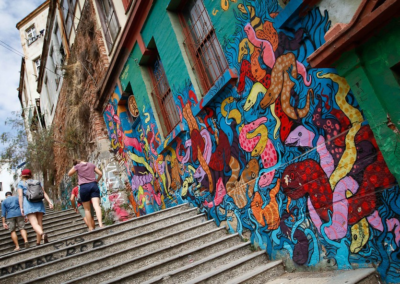South American street art is much more than just colorful murals on city walls. It’s a vibrant form of expression that captures the heart and soul of the continent’s diverse cultures. Across South America, from the bustling streets of Buenos Aires to the historic lanes of Bogota, street art tells stories, celebrates cultural heritage, and even sparks conversations on social issues. This art form goes beyond mere decoration; it reflects the people’s lives, struggles, and aspirations. South American street art is not just about creating beauty; it’s about voicing the unspoken and showcasing the rich tapestry of cultural narratives that define this part of the world.
The Roots of South American Street Art

The history of street art in South America is deeply rooted in its cultural and social environment. Long before it gained global recognition, street art was a medium for local artists to express their identity, often influenced by indigenous cultures. These artists used the streets as their canvas to showcase their ancestors’ rich traditions, myths, and stories. Indigenous motifs, symbols, and themes are common in the works of many renowned South American street artists, creating a visual conversation between the past and the present.
This blend of contemporary art with traditional influences makes South American street art unique. It’s a reflection of modern society and a tribute to the indigenous cultures that have shaped the continent’s history. From the vibrant colors to the symbolic imagery, each piece of street art is a window into the soul of South America, its people, and its enduring spirit.
South American Street Art as a Voice for the Community

South American street art is not just about vibrant colors or bold designs; it’s a powerful tool for community expression. In many cities across the continent, street murals have become canvases for social commentary. Artists often use their work to highlight important issues like poverty, corruption, and human rights, giving a voice to those who might otherwise go unheard. This art form bridges gaps, bringing together people from different backgrounds and sparking crucial conversations. It’s a way for communities to tell their stories, share their concerns, and inspire change.
Transforming Public Spaces

Street art in South America plays a crucial role in transforming and enhancing public spaces. In many urban areas, especially economically disadvantaged ones, vibrant murals turn bland walls and neglected buildings into works of art. This beautification process can breathe new life into neighborhoods, creating inviting and inspiring environments. Beyond aesthetics, these colorful displays can boost community pride and foster a sense of belonging among residents. In areas where resources are limited, street art becomes a low-cost, high-impact tool for uplifting communities and creating spaces where people feel connected and represented.
South American Street Art: Artists and Their Iconic Works
South American street art is marked by extraordinary works from talented artists. In Buenos Aires, Martin Ron’s mural of a giant sea turtle stands out. This mural, depicting a man and his dog under the shadow of the turtle, is famous for its expression of memory’s power. Meanwhile, in Bogota, Elliot Tupac’s ‘Esperanza’ is a notable piece. Tupac, known for his ‘chicha art,’ blends traditional aesthetics with modern themes, showcasing indigenous culture’s richness and its influence in modern society. His art is a vibrant reminder of the enduring indigenous identity in urban and rural Peru.
The Impact of Street Art on Tourism
Street art has become a significant attraction for tourists in South America. Vibrant murals and graffiti have transformed city walls into open-air galleries, drawing visitors from around the world. This interest in street art boosts local economies, as tourists often spend money on tours, dining, and shopping in areas known for their street art. Cities like Buenos Aires and Bogota have seen a positive impact from this trend, as street art contributes to the cultural allure that makes these destinations unique. Through its visual appeal and cultural richness, South American street art has become a vital part of the tourism landscape.
Preserving and Promoting Street Art
Preserving street art is a challenge, as it’s often exposed to weather and sometimes seen as vandalism. Efforts to protect and recognize this art form are growing. Cities are creating designated spaces for street murals, which helps prevent the art from being painted over or damaged. Also, art organizations are working to educate people about the value of street art, promoting it not just as graffiti but as an important cultural expression. These steps are vital in ensuring that street art remains a vibrant and respected part of South American culture.
Discover and Support Street Art through Engaged Education
South American street art is a vibrant and essential part of the continent’s cultural fabric. It gives a voice to communities, transforms spaces, and invites global tourists to engage with local stories. This art form, from murals to graffiti, holds a mirror to society, reflecting its history, struggles, and dreams.
Engaged Education offers an opportunity to dive deeper into the world of South American street art. Through our educational tours, you’ll experience this dynamic art form firsthand and understand its impact on communities. Download our Engaged Education brochure to join us on a journey that goes beyond traditional tourism, creating a deeper connection with cultures and their expressions. Explore, learn, and be part of a movement that celebrates global citizenship and cultural appreciation.
To find out more about Engaged Education and how you can get involved, fill out our interest form below!







